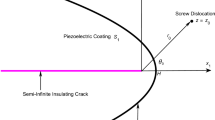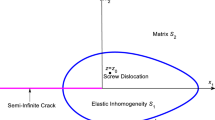Abstract
The interaction between a screw dislocation and an oblique edge crack in a semi-infinite piezoelectric medium under remote anti-plane mechanical and in-plane electrical loadings is studied in this article. The screw dislocation suffers a finite discontinuity in the displacement and electric potential across the slip plane. The dislocation also has a line force and a line charge along its core. In the framework of linear piezoelectricity theory, the analytical solutions are derived from the complex variable and Schwarz–Christoffel transformation. Furthermore, the electric field, stress field, generalized stress intensity factor, image force and crack extension force are formulated exactly. Numerical calculations are then given graphically for studying the effects of crack length, crack angle and load position on these electric mechanical parameters. Besides, the dislocation solutions proposed here can be served as Green’s functions for the analyses of corresponding piezoelectric cracking or distributed loading problems.











Similar content being viewed by others
References
Pak YE (1990) Crack extension force in a piezoelectric material. ASME J Appl Mech 57:647–653
Zhang PY, Tong P (1996) Fracture mechanics for a mode III crack in a piezoelectric material. Int J Solids Struct 33:343–359
Zhong SM, Meguid SA (1997) Analysis of a circular arc-crack in piezoelectric materials. Int J Fract 84:143–158
Li XF, Tang GJ (2003) Anti-plane interface crack between two bonded dissimilar piezoelectric layers. Eur J Mech A/Solids 22:231–242
Li XF, Lee KY (2004) Electroelastic behavior of a rectangular piezoelectric ceramic with an anti-plane shear crack at arbitrary position. Eur J Mech A/Solids 23:645–658
Pak YK (1990) Force on a piezoelectric screw dislocation. ASME J Appl Mech 57:863–869
Kattis MA, Providas E, Kalamkarov AL (1998) Two-phase potentials in the analysis of smart composites having piezoelectric components. Compos Part B Eng 29:9–14
Meguid SA, Deng W (1998) Electro-elastic interaction between a screw dislocation and elliptical inhomogeneity in piezoelectric materials. Int J Solids Struct 35:1467–1482
Lee KY, Lee WG, Pak YE (2000) Interaction between a semi-infinite crack and a screw dislocation in a piezoelectric material. J Appl Mech 67:165–170
Liu YW, Fang QH, Jiang CP (2004) A piezoelectric screw dislocation interacting with an interphase layer between a circular inclusion and the matrix. Int J Solids Struc 41:3255–3274
Jin B, Fang QH (2008) Piezoelectric screw dislocations interacting with an inhomogeneity with imperfect interface. Arch Appl Mech 78:105–116
Shen MH, Chen SN, Lin CP (2012) A piezoelectric screw dislocation interacting with a half-plane trimaterial composite. Meccanica 43:1923–1933
Shen MH, Chen SN, Lin CP (2012) The interaction between a screw dislocation and a piezoelectric fiber composite with a wedge crack. Arch Appl Mech 82:215–227
Choi SR, Shin JK (2012) Three collinear interfacial cracks in dissimilar piezoelectric materials. Int J Fract 179:L237–L244
Craciun EM, Baesu E, Soόs E (2005) General solution in terms of complex potentials for incremental antiplane states in prestressed and prepolarized piezoelectric crystals. IMA J Appl Math 70:39–52
Baesu E, Fortuné D, Soόs E (2003) Incremental behaviour of hyperelastic dielectrics and piezoelectric crystals. J Appl Math Phys (ZAMP) 54:160–178
Baesu E, Soόs E (2001) Antiplane fracture in a prestressed and prepolarized piezoelectric crystal. IMA J Appl Math 66:449–508
Guo JH, Lu ZX, Han HT, Yang Z (2010) The behavior of two non-symmetrical permeable cracks emanating from an elliptical hole in a piezoelectric solid. Eur J Mech A/Solids 29:654–663
Guo JH, Lu ZX, Feng X (2010) The fracture behavior of multiple cracks emanating from a circular hole in piezoelectric materials. Acta Mech 215:119–134
Li XF, Fan TY (2001) Mode-III interface edge crack between bonded quarter-planes of dissimilar piezoelectric materials. Arch Appl Mech 71:703–714
Li XF, Tang GJ (2002) Anti-plane permeable edge cracks in a piezoelectric strip of finite width. Int J Fract 115:L35–L40
Wu XF, Dzenis YA, Zou WS (2002) Screw dislocation interacting with an interfacial edge crack between two bonded dissimilar piezoelectric wedges. Int J Fract 117:L9–L14
Wu XF, Dzenis YA, Fan TY (2003) Screw dislocation interacting with twin interfacial edge cracks between two bonded dissimilar piezoelectric strips. Mech Res Commu 30:547–555
Guo JH, Lu ZX, Han HT, Yang Z (2009) Exact solutions for anti-plane problem of two asymmetrical edge cracks emanating from an elliptical hole in a piezoelectric material. Int J Solids Struc 46:3799–3809
Wang SD, Lee S (1999) Screw dislocation near a slant edge crack. Mech Mater 31:63–70
Beom HG, Cui CB (2011) Oblique edge crack in an anisotropic material under anti-plane shear. Euro J Mech A/Solids 30:893–901
England AH (1971) Complex variable methods in elasticity. Wiley, London
Acknowledgments
This research is supported by the Ministry of Science and Technology of ROC under the contract number: MOST 103-2221-E-252-003.
Author information
Authors and Affiliations
Corresponding author
Appendix
Appendix
-
(a)
The derivation of (38).
From (14)
-
(b)
The derivation of (39)
From (51),
From (52),
From (57),
substituting (55), (56) and (58) into (54) and (53), get
Rights and permissions
About this article
Cite this article
Shen, MH., Hung, SY. Screw dislocation near a piezoelectric oblique edge crack. Meccanica 51, 1445–1456 (2016). https://doi.org/10.1007/s11012-015-0303-0
Received:
Accepted:
Published:
Issue Date:
DOI: https://doi.org/10.1007/s11012-015-0303-0




